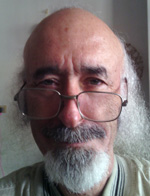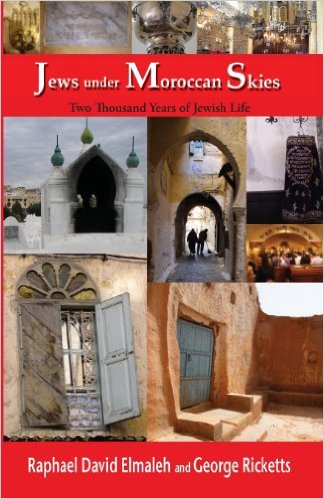By Dan Bloom

CHIAYI CITY, Taiwan — As the motto of this website intones, “there’s a Jewish story everywhere,” and I found a good one in Morocco.
It’s about a Moroccan Jew named Raphael Elmaleh and a Scottish expat living in Morocco named George Ricketts. They two men teamed up to write a guide book to Morocco titled ‘Jews under Moroccan Skies: Two Thousand Years of Jewish Life, and I recently sat down via long distance email to interview the two men, with Ricketts doing the English-language messaging.
When I asked how the project got started, Ricketts told San Diego Jewish World that he first met Elmaleh around 1992, a year after he had left Scotland and settled in Casablanca.
“We met at the offices of an international Jewish organization which looks after the needs of the elderly and poor members Morocco’s Jewish community,” he recalled. “As it turned out, we were actually close neighbors in the same district of Casablanca.”
Elmaleh traces his family roots back five generations to the predominately Berber town of Demnate, in the region of the Middle Atlas. His surname is derived from the Arabic word for salt. And as a matter of fact, Ricketts told me, the ancestral occupation of past members of the family was as sellers of the once valuable commodity of salt.
“I had known for several years that Raphael was a tourist guide, specializing in Moroccan Jewish heritage tours,” Ricketts said. “But it was not until 2007 that I discovered and became fascinated by his knowledge of Moroccan Jewish history and culture, which up until then I knew very little about. I overheard him answering questions put to him by a tourist group of Jewish Americans. When I heard the replies, I realized immediately what he was saying had to be written down in a book. I could add my previous knowledge of Moroccan history, geography and culture, which in many respects pertained to Morocco’s Jews. Some research into the history and culture of Moroccan Jews would augment my contribution and, at the same time, provide me with invaluable knowledge of the subject.”
So the book project was born, with the two men serving as co-authors.
“I am more than eager and proud to inform the world of my rich Jewish heritage,” Elmaleh told Ricketts when he pitched the travel book concept to him. That heritage included restored synagogues, former mellahs (Jewish quarters) still standing, a Jewish Museum, the veneration of Moroccan tzadikim (rabbinical saints), and how it was possible for Jews and Muslims to co-exist over the centuries.
“We felt confident that we were up to the task, and agreed to write the book together,” Ricketts said. ”As we write in our book, historical documents indicate Jews left Jerusalem after the destruction of the second Temple, and some Jews seemed to have settled in Morocco. More Jews later migrated westward from other North African countries and established trading posts on the coastal areas of Morocco.”
According to Ricketts, scattered clusters of Jewish communities established themselves throughout the deep south of the country to take commercial advantage of the Sub-Saharan caravan routes, and these particular Jews integrated with the indigenous Berbers, many of whom converted to Judaism. They became known as Berber Jews.
In addition, several thousand Jews came from Spain and Portugal after being expelled in 1492 for refusing to convert to Catholicism, he said. They became known as the Sephardic Jews.
How did Jews fare in Morocco?
“Moroccan Jewish history reveals periods when the Jews were treated harshly by certain rulers,” Ricketts said. “For example, Jews and non-Muslims were classified as Dhimmis-ahl-al-Dhimma (‘People of the Book’), and were required to pay a special head tax, said to be for protection. ”
In addition, forced conversions took place during the 12th and 13th centuries when the Almohad dynasty ruled, he noted, in consultation with Elmaleh.
“However, other rulers and dynasties gave Jews preferential treatment when it came to matters of commerce. Jews also served as diplomats, ministers, counselors and financial advisors to certain sultans,” Ricketts said.
For example, Andre Azoulay, a distinguished Moroccan Jew, served as an advisor to the late King Hassan II, and is presently in the same role with his successor King Mohamed VI.
As the book notes, there was some tension around the time of the formation of Israel as a new nation in the 1947-1948 period, according to the co-authors. There was also resentment within some sectors of Moroccan society when Israel won the Six Day War in 1967.
“In contemporary times, the now small Jewish community, around 4,000 people, is treated with respect by Moroccan Muslims, and they are regarded as fellow Moroccan citizens in every way,” Ricketts said.
The book was published by Gaon Books in New Mexico in 2013 and it still available for order via Amazon. How Ricketts found a publisher is a story in itself, and he tells it this way: “Successfully finding a publisher, some people have said on hearing my story, appeared to be divine intervention. I am not what you would call a religious man, but the moment it happened and how it happened certainly left me in some kind of spin.”
While searching the Internet for some information about the Jews of Tetouan, Ricketts came across a website with a photograph a Western-looking man standing inside a synagogue. His curiosity got him wondering who the man was and why he was there. Scrolling down to the bottom of the page, Ricketts discovered he was a publisher of Gaon books specializing in Jewish genre.
“I immediately sent the book proposal to the email address listed on the site,” Ricketts said. “The response from Gaon was positive, and a few months later the book was launched onto the market.”
Sales of the book have gone well. Many readers told the co-authors how enthralled they were to find so much information and valuable history included in the book. In addition, several descendants of Jewish families once living in Morocco and now scattered around the world have shown great emotion after reading the book, Ricketts said.
According to Elmaleh, many Jewish people, after reading the book, have come in large numbers to Morocco on Jewish heritage tours. Several bring their copies of the book with them, saying it is a must-have for Jewish tourists visiting the country, he said.
Official figures estimate that around 6,000 tourists came to Morocco on these tours in 2015, which included Jews from the U.S., Canada, Israel, Australia and Britain. Elmaleh, the guide and co-author, is fully booked until April 2016, according to Ricketts.
The book has also spurred influential members of Morocco’s Jewish community to seek financial assistance abroad for the restoration of Jewish sites around the country. The mellah of Marrakech is one example, Ricketts said.
“Jewish tourists always comment on how surprised and amazed they are when they witness how Moroccan Muslims and Moroccan Jews blend together in harmony and co-existence,” he added. “One observant Jewish tourist was heard to remark: ‘It’s because they have lived side by side for more than two-thousand years.'”
*
Bloom, based in Taiwan, is an inveterate web surfer. He may be contacted via dan.bloom@sdjewishworld.com. Comments intended for publication in the space below must be accompanied by the letter writer’s first and last name and by his/her city and state of residence (city and country for those outside the U.S.)

Pingback: Guide Books | Travelguide
Pingback: Marrakech Travel Info